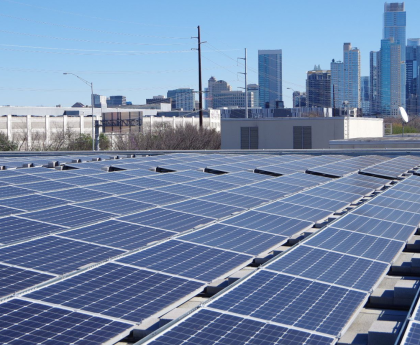Floating solar panels on existing hydropower reservoirs could, in the best-case scenario, make it unnecessary to construct any of the new hydropower dams currently planned in Africa, according to a new analysis. The study is among the first to analyze the potential for floating solar panels (or FPV, short for floating photovoltaics) at a continental scale.
Population growth and economic development are predicted to triple Africa’s electricity demand by 2050. Meanwhile, hydropower generation has become less certain because of climate change-related droughts.
Putting solar panels on hydropower reservoirs has gained increasing attention in the past few years and has a lot of potential advantages. Floating solar panels may generate electricity more efficiently than land-based panels because the water helps cool them to an optimum operating temperature, and the electricity they generate can be fed right into the grid via the hydropower dam’s existing infrastructure.
“Floating photovoltaics (FPV) is fast becoming cost-competitive, but its social and environmental impacts are under debate,” researchers write in a paper published in Nature Energy. “Meanwhile, developing economies anticipate hundreds of new dams over the next decade, with social and environmental implications for the next century.”
In the new study, researchers used a comprehensive model of the energy system across the entire African continent to explore the tradeoffs among energy production, agriculture, environmental protection, and economic development involved with floating solar.
FPV power production potential varies from one region of Africa to another. But if floating solar panels were deployed as widely as possible across the continent, they could produce between 20 and 100% of the electricity expected from hydropower dams currently slated for construction in Africa, the researchers report.
Floating solar could supply 6-7% of the continent’s total projected energy demand in 2050. The most cost-effective way to incorporate floating solar in Africa’s energy system depends on the panels’ efficiency and their cost.
The researchers also conducted a case study of FPV and hydropower potential in the Zambezi watercourse, a river system that traverses eight countries in southern Africa. This analysis showed that it would be more efficient to take the money earmarked for new dams in the river system and use it to build floating solar instead.
This approach would result in an electricity generation system with 12% less variability from year to year compared to a hydropower-heavy approach. “Adopting FPV in place of intensive hydropower development results in a more predictable output over longer timescales, which could lead to greater electricity reliability and lower reliance on imports in times of drought,” the researchers write. In other words, floating solar is a strategy for climate change resilience.
Floating solar does have drawbacks, such as disrupting existing uses like fishing and recreation on reservoirs. But new hydropower dams have much bigger environmental and social impacts, the researchers point out, and are prone to cost overruns as well.
Source: . et al. “Floating photovoltaics may reduce the risk of hydro-dominated energy development in Africa.” Nature Energy 2024.
Image: Politecnico de Milano.
Our work is available free of charge and advertising. We rely on readers like you to keep going. Donate Today
This post was originally published on 3rd party site mentioned in the title of this site






